Calculation of Displacement-Dependent Active Earth Pressure for Deep Excavations in Soft Soil
Abstract
:1. Introduction
2. Materials and Methods
2.1. Test Apparatus
2.2. Test Specimens
2.3. Testing Program
2.4. Test Results and Analysis
2.5. Model Validation
3. Expression for Displacement-Dependent Active Earth Pressure
3.1. Soil Strain Distribution
3.2. Validation of Earth Pressure Prediction
3.3. Illustrative Example
4. Conclusions
- (1)
- Based on the analysis of the lateral unloading stress path triaxial test results, a hyperbolic model was proposed. The comparison between the predictions and test results showed that the proposed model can successfully estimate the radial stress from the soil strain for soft clay under various initial radial stresses.
- (2)
- According to a basic hypothesis of the soil, a simplified soil strain distribution assumption was applied to allow for the proposal of a displacement-dependent active earth pressure model. The proposed model was validated by comparison with the experimental results, showing it to be a valid model for estimating the magnitude and distribution of active earth pressure, with a consideration of the displacement of the supporting structure. More work needs to be performed given that the prediction deviation resulting from the model reflected a neglect in the interaction between the support structures and the soil mass.
- (3)
- Through an inversion of the proposed model, we confirmed that the earth pressure along the entire depth of the wall could not achieve the active condition simultaneously. This confirmed the validity of our calculation of displacement-dependent active earth pressure for deep excavations. The assumption that the required magnitude of movement of the entire soil in the fully active condition is 1% of the excavation depth is not suitable for a multi-strutted, soft-ground foundation pit; however, this assumption may be reasonable for the retaining walls rotating around the bottom.
- (4)
- The present experimental work is limited to the Nanjing floodplain muddy clay. For more generalizable conclusions, further exploration should be carried out for other soils.
Author Contributions
Funding
Institutional Review Board Statement
Informed Consent Statement
Data Availability Statement
Conflicts of Interest
References
- DG/TJ 08-6l-2018; Technical Code for Excavation Engineering. Tongji University Press: Shanghai, China, 2018.
- DB33/T 1096-2014; Technical Specification for Building Foundation Excavation Engineering. Zhejiang Gongshang University Press: Hangzhou, China, 2014.
- Clough, G.; Duncan, J.W. Earth Pressures, Chapter 6, Foundation Engineering Handbook; Fang, H.-Y., Ed.; Springer: New York, NY, USA, 1991; pp. 223–235. [Google Scholar]
- Becker, D.E.; Moore, I.D. Canadian Foundation Engineering Manual; Canadian Geotechnical Society: Alliston, Canada, 2006; p. 396. [Google Scholar]
- Yue, Z.; Peng, Y.; Zhang, S. The centrifugal model test of compacted cohesive fill Earth pressure on retaining wall. Chin. J. Geotech. Eng. 1992, 6, 90–96. (In Chinese) [Google Scholar]
- Ou, C.-Y.; Liao, J.-T.; Lin, H.-D. Performance of Diaphragm Wall Constructed Using Top-Down Method. J. Geotech. Geoenviron. Eng. 1998, 124, 798–808. [Google Scholar] [CrossRef]
- Tan, Y.; Wang, D. Characteristics of a Large-Scale Deep Foundation Pit Excavated by the Central-Island Technique in Shanghai Soft Clay. II: Top-Down Construction of the Peripheral Rectangular Pit. J. Geotech. Geoenviron. Eng. 2013, 139, 1894–1910. [Google Scholar] [CrossRef]
- Jayatheja, M.; GuhaRay, A. Earth Pressures on Retaining Walls backfilled with Red Soil admixed with Building Derived Materials under Rotational Failure mode. Géoméch. Geoengin. 2021, 17, 1011–1021. [Google Scholar] [CrossRef]
- Rui, R.; Ye, Y.-Q.; Han, J.; Zhang, L.; Zhai, Y.-X. Experimental and Theoretical Investigations on Active Earth Pressure Distributions behind Rigid Retaining Walls with Narrow Backfill under a Translational Mode. Int. J. Géoméch. 2020, 20, 04020178. [Google Scholar] [CrossRef]
- Fang, Y.S.; Ishibashi, I. Static earth pressures with various wall movements. J. Geotech. Eng. 1986, 112, 317–333. [Google Scholar] [CrossRef]
- Bang, S. Active Earth Pressure Behind Retaining Walls. J. Geotech. Eng. 1985, 111, 407–412. [Google Scholar] [CrossRef]
- Chang, M.F. Lateral earth pressures behind rotating walls. Can. Geotech. J. 1997, 34, 498–509. [Google Scholar] [CrossRef]
- Lu, K.; Yang, Y. Preliminary study of active earth pressure under nonlimit state. Rock Soil Mech. 2010, 31, 615–619. (In Chinese) [Google Scholar]
- Lu, K.; Yang, Y. Approximate calculation method of active earth pressure considering displacement. Rock Soil Mech. 2009, 30, 553–557. [Google Scholar]
- Xu, R.Q.; Liao, B.; Wu, J.; Chang, S. Computational method for active earth pressure of cohesive soil under nonlimit state. Rock Soil Mech. 2013, 34, 148–154. (In Chinese) [Google Scholar]
- Yang, T.; He, H. Displacement-earth pressure theory for cohesive soil based on shear strength reduction. Rock Soil Mech. 2009, 30, 185–188. [Google Scholar]
- Zhu, J.-F.; Xu, R.-Q.; Li, X.-R.; Chen, Y.-K. Calculation of earth pressure based on disturbed state concept theory. J. Cent. South Univ. Technol. 2011, 18, 1240–1247. [Google Scholar] [CrossRef]
- Liu, G.; Wang, W. Foundation Engineering Handbook; China Architecture & Building Press: Beijing, China, 2009. [Google Scholar]
- Mei, G.; Chen, Q.; Song, L. Model for predicting displacement-dependent lateral earth pressure. Can. Geotech. J. 2009, 46, 969–975. [Google Scholar] [CrossRef]
- Ni, P.; Mangalathu, S.; Song, L.; Mei, G.; Zhao, Y. Displacement-Dependent Lateral Earth Pressure Models. J. Eng. Mech. 2018, 144, 04018032. [Google Scholar] [CrossRef]
- Chen, Y.K.; Xu, R.Q.; Yang, X.J.; Gong, X.N. A New Method Calculating Earth Pressure on Flexible Structures for Excavation Work. Ind. Constr. 2001, 31, 1–4. (In Chinese) [Google Scholar]
- Zhang, W.; Li, N. The Method of Earth Pressure Calculationunder the State of Unlimited Equilibrium. J. QingHai Univ. 1999, 17, 8–11+46. (In Chinese) [Google Scholar]
- Zhang, W.; Tian, J.; Wang, B.T. Relationship between earth pressure on support structure of foundation pits and displacement of earth mass. J. Hohai Univ. (Nat. Sci.) 2005, 33, 575–579. (In Chinese) [Google Scholar]
- Lu, G.S. A calculation method of earth pressure considering displacement. Rock Soil Mech. 2004, 25, 586–589. (In Chinese) [Google Scholar]
- Zhang, J.-M.; Shamoto, Y.; Tokimatsu, K. Evaluation of Earth Pressure Under Any Lateral Deformation. Soils Found. 1998, 38, 15–33. [Google Scholar] [CrossRef] [Green Version]
- Mei, G.-X.; Chen, R.; Liu, J. New Insight into Developing Mathematical Models for Predicting Deformation-Dependent Lateral Earth Pressure. Int. J. Géoméch. 2017, 17, 06017003. [Google Scholar] [CrossRef]
- Tang, Y.; Li, J.P.; Ma, Y. Lateral Earth Pressure Considering the Displacement of a Rigid Retaining Wall. Int. J. Géoméch. 2018, 18, 06018031. [Google Scholar] [CrossRef]
- Milligan, G.W.E. Soil deformations near anchored sheet-pile walls. Géotechnique 1983, 33, 41–55. [Google Scholar] [CrossRef]
- Lu, P.Y.; Yan, C.; Liu, R. Research on distribution of earth pressure of clay obtained from model test in laboratory. J. Build. Struct. 2002, 23, 83–86. (In Chinese) [Google Scholar] [CrossRef]
- Ertugrul, O.L.; Trandafir, A.C. Lateral earth pressures on flexible cantilever retaining walls with deformable geofoam inclusions. Eng. Geol. 2013, 158, 23–33. [Google Scholar] [CrossRef]
- Conte, E.; Pugliese, L.; Troncone, A. Earthquake-induced permanent displacements of embedded cantilever retaining walls. Géotechnique 2022, 72, 1–10. [Google Scholar] [CrossRef]
- Li, J.P.; Ma, Y.; Rao, P.P. Calculation of earth pressure against flexible retaining wall considering displacement. Rock Soil Mech. 2012, 33, 2937–2941. [Google Scholar]
- Ying, H.W.; Cai, Q.P. Distribution of active earth pressure against flexible retaining walls with drum deformation. Chin. J. Geotech. Eng. 2008, 30, 1805–1810. (In Chinese) [Google Scholar] [CrossRef]
- Ying, H.W.; Zhu, W.; Zheng, B.B.; Wang, X.G. Calculation and distribution of active earth pressure against flexible retaining walls. Chin. J. Geotech. Eng. 2014, 36, 1–6. (In Chinese) [Google Scholar] [CrossRef]
- Huang, M.; Liu, X.-R.; Zhang, N.-Y.; Shen, Q.-W. Calculation of foundation pit deformation caused by deep excavation considering influence of loading and unloading. J. Cent. South Univ. 2017, 24, 2164–2171. [Google Scholar] [CrossRef]
- Ji, X.; Ni, P.; Barla, M.; Zhao, W.; Mei, G. Earth pressure on shield excavation face for pipe jacking considering arching effect. Tunn. Undergr. Space Technol. 2018, 72, 17–27. [Google Scholar] [CrossRef]
- Ni, P.; Song, L.; Mei, G.; Zhao, Y. On predicting displacement-dependent earth pressure for laterally loaded piles. Soils Found. 2018, 58, 85–96. [Google Scholar] [CrossRef]
- Ni, P.; Mei, G.; Zhao, Y.; Chen, H. Plane strain evaluation of stress paths for supported excavations under lateral loading and unloading. Soils Found. 2018, 58, 146–159. [Google Scholar] [CrossRef]
- Tang, L.; Cong, S.; Xing, W.; Ling, X.; Geng, L.; Nie, Z.; Gan, F. Finite element analysis of lateral earth pressure on sheet pile walls. Eng. Geol. 2018, 244, 146–158. [Google Scholar] [CrossRef]
- Shao, L.T.; Liu, G.; Zeng, F.T.; Guo, X.X. Recognition of the Stress-Strain Curve Based on the Local Deformation Measurement of Soil Specimens in the Triaxial Test. Geotech. Test. J. 2016, 39, 658–672. [Google Scholar] [CrossRef]
- Zeng, F.; Shao, L. Unloading Elastic Behavior of Sand in Cyclic Triaxial Tests. Geotech. Test. J. 2016, 39, 462–475. [Google Scholar] [CrossRef]
- Zhang, R.; Zheng, J.L.; Yang, H.P. Experimental Study on K0 Consolidation Behavior of Recompacted Unsaturated Expansive Soil. In Proceedings of the Geohunan International Conference, Changsha, China, 3–6 August 2009; pp. 27–32. [Google Scholar] [CrossRef]
- Muñoz-Castelblanco, J.; Delage, P.; Pereira, J.-M.; Cui, Y. On-sample water content measurement for a complete local monitoring in triaxial testing of unsaturated soils. Géotechnique 2012, 62, 595–604. [Google Scholar] [CrossRef] [Green Version]
- Santana, T.; Candeias, M. K0 measurement in a sand using back volume change. Soils Rocks 2015, 38, 3–8. [Google Scholar] [CrossRef]
- GB/T 50123-2019; Standard for Geotechnical Testing Method. MOHURD (Ministry of Housing and Urban-Rural Development of the People’s Republic of China): Beijing, China, 2019.
- Esmaeili-Falak, M.; Katebi, H.; Vadiati, M.; Adamowski, J. Predicting Triaxial Compressive Strength and Young’s Modulus of Frozen Sand Using Artificial Intelligence Methods. J. Cold Reg. Eng. 2019, 33, 04019007. [Google Scholar] [CrossRef]
- Esmaeili-Falak, M.; Katebi, H.; Javadi, A.A. Effect of Freezing on Stress–Strain Characteristics of Granular and Cohesive Soils. J. Cold Reg. Eng. 2020, 34. [Google Scholar] [CrossRef]
- Janbu, N. Soil compressibility as determined by oedometer and triaxial tests. In Proceedings of the European Conference on Soil Mechanics and Foundation Engineering, Wiesbaden, Germany, 15–18 October 1963; pp. 19–25. [Google Scholar]
- Duncan, J.M.; Chang, C.-Y. Nonlinear Analysis of Stress and Strain in Soils. J. Soil Mech. Found. Div. 1970, 96, 1629–1653. [Google Scholar] [CrossRef]
- Caspe, M.S. Surface settlement adjacent to braced open cuts. J. Soil Mech. Found. Eng. 1966, 92, 51–59. [Google Scholar] [CrossRef]
- Liu, X.; Yi, D.; Shi, Z. Theoretical analysis of surface settlement during excavation. China Civ. Eng. J. 2000, 33, 51–55. (In Chinese) [Google Scholar] [CrossRef]
- Li, B.; Zhao, X.H. A nonlinear earth pressure method for deep excavation considering deformation of retaining wall. Rock Soil Mech. 2004, 25, 453–458. (In Chinese) [Google Scholar] [CrossRef]
- Xu, Q.W.; Ma, X.F.; Zhu, H.H.; Ding, W. Centrifugal model test on extra-deep foundation pit excavations in soft ground. China Civ. Eng. J. 2009, 42, 154–161. (In Chinese) [Google Scholar]
- Sheng, Z.Q. Experimental Study on Engineering Properties of Foundation Soil Related to Excavation Progress. Ph.D. Thesis, China Academy of Building Research, Beijing, China, 2016. (In Chinese). [Google Scholar]
- Wang, W.D.; Wang, H.R.; Xu, Z.H. Simplified method of deformation prediction for excavations retained by embedded walls in Shanghai soft soil. Chin. J. Geotech. Eng. 2012, 34, 1792–1800. [Google Scholar]

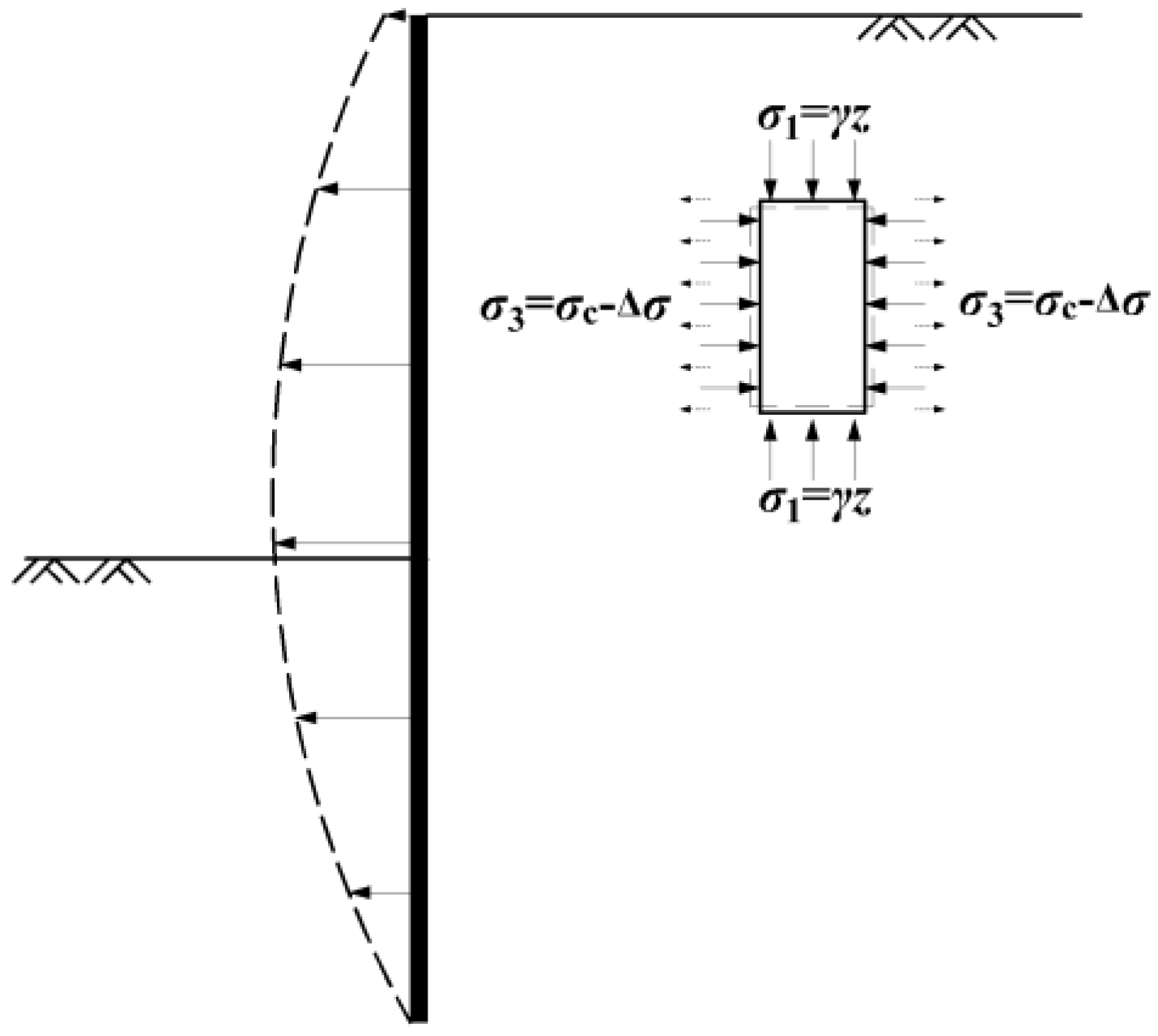
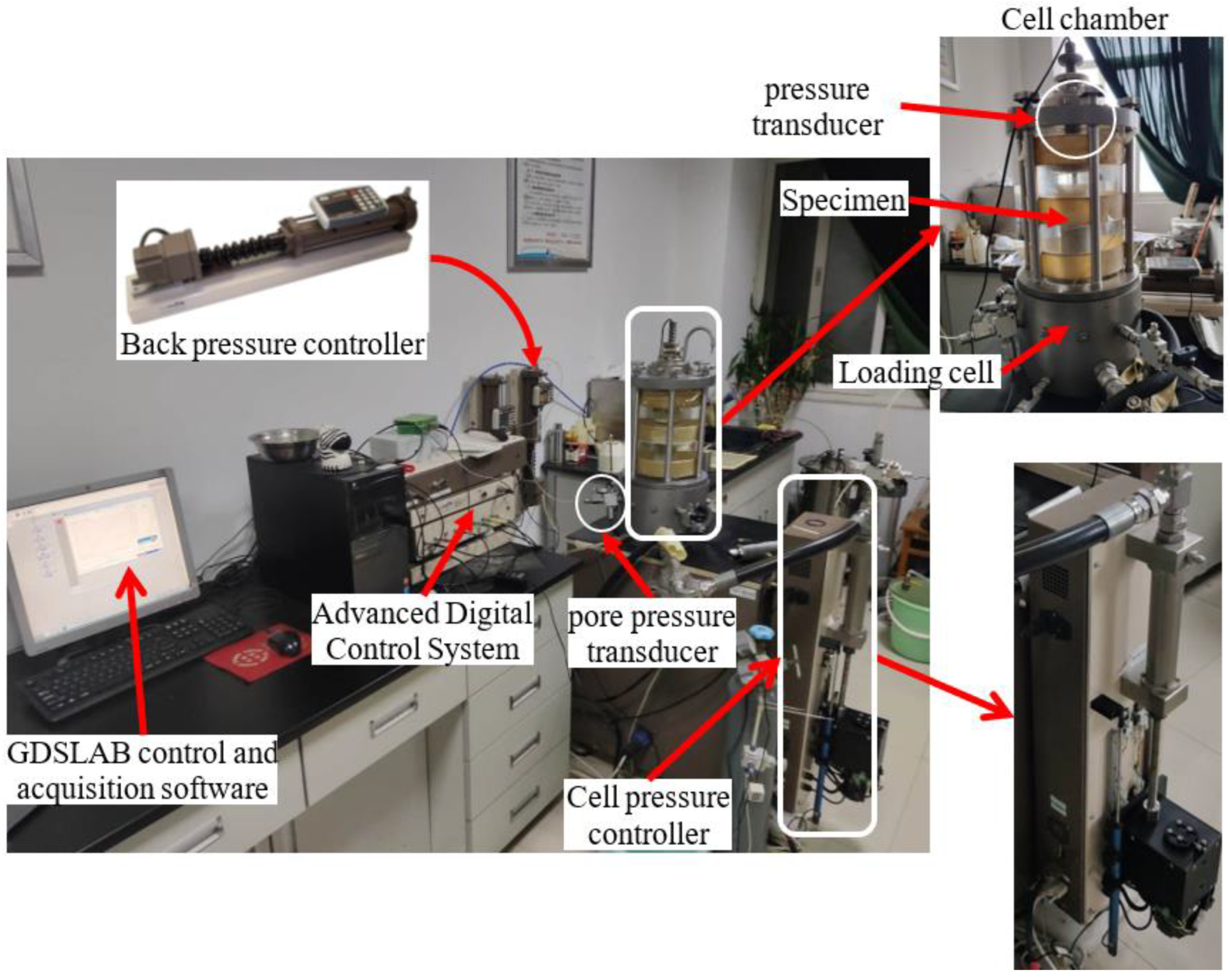
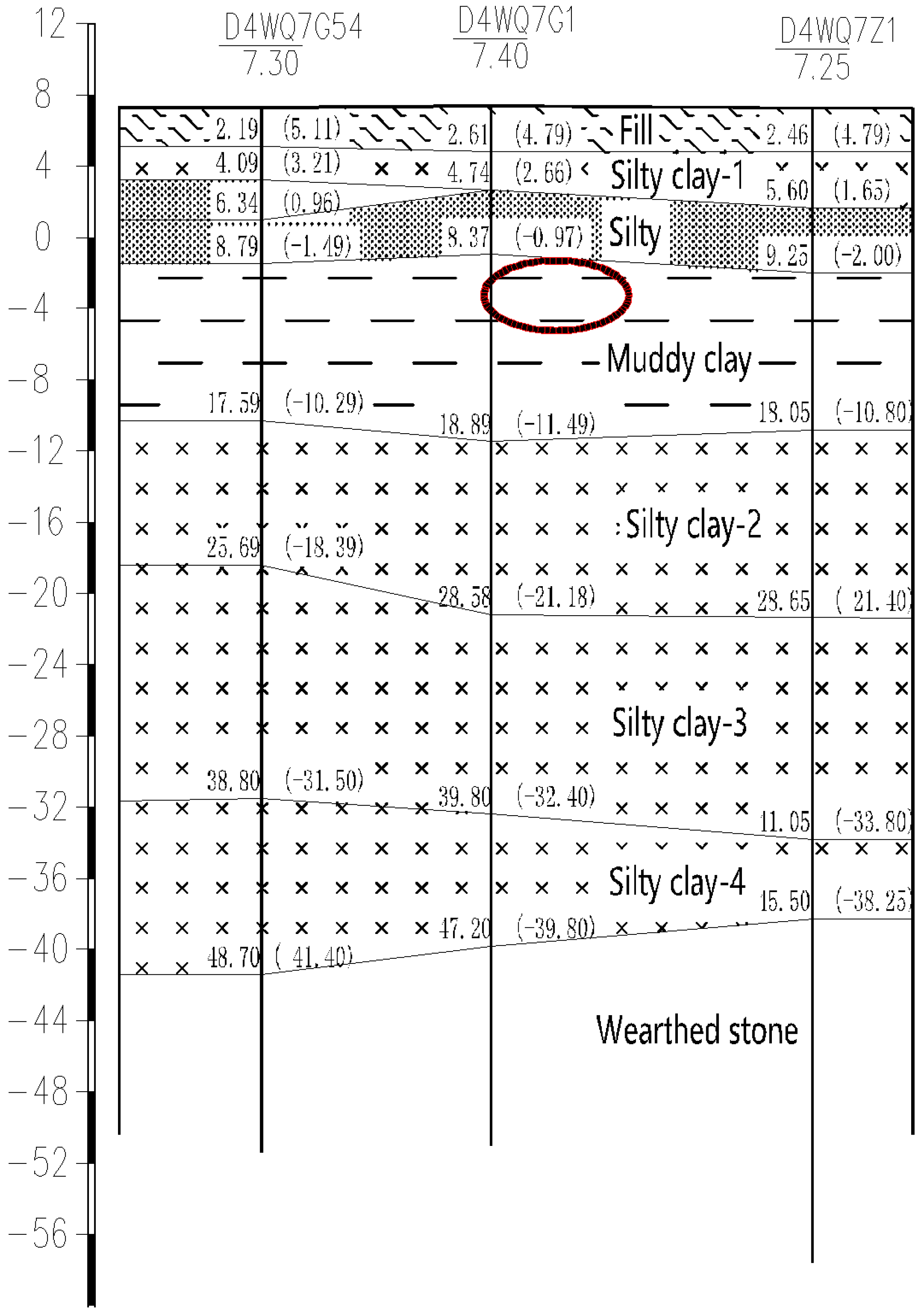

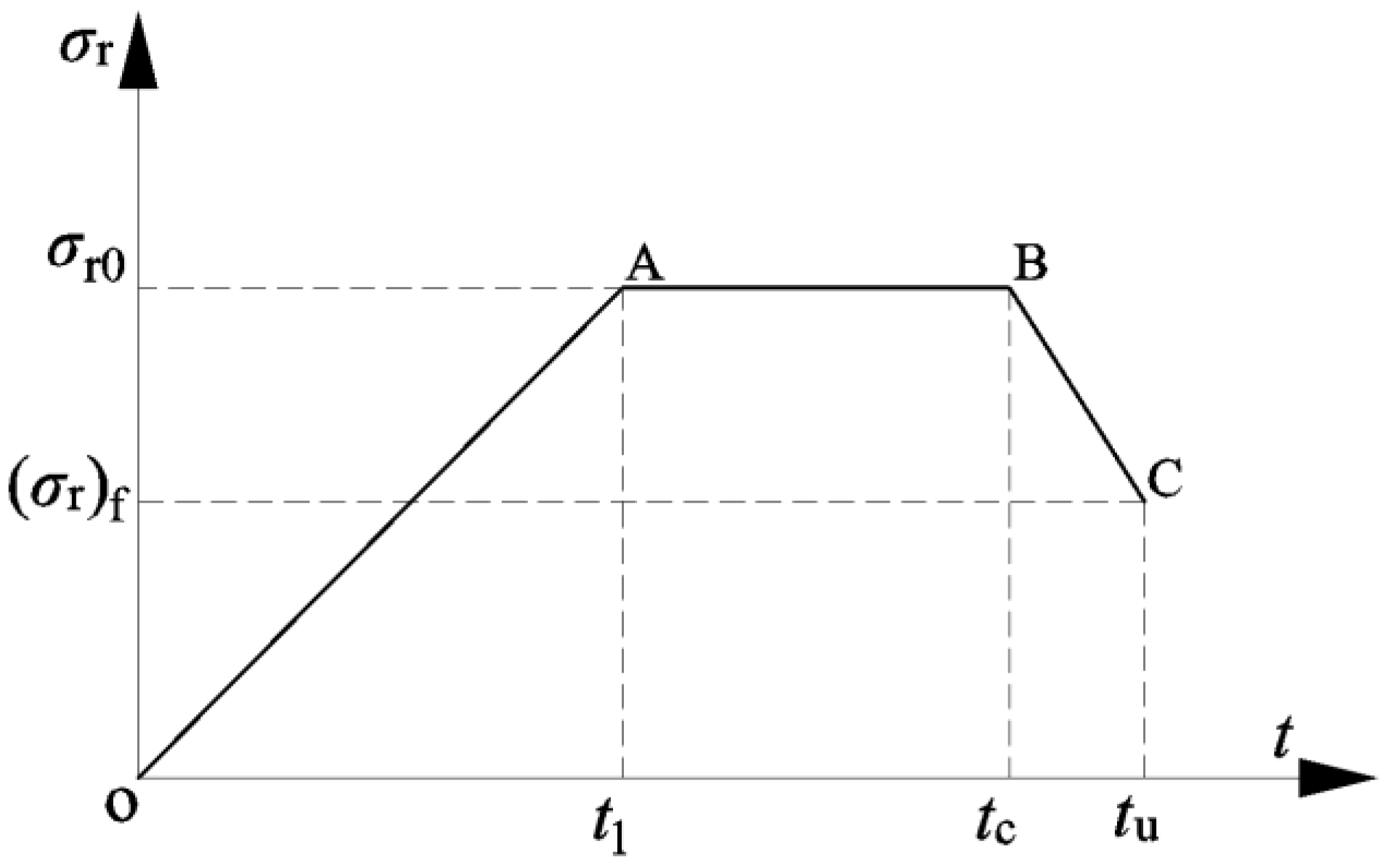


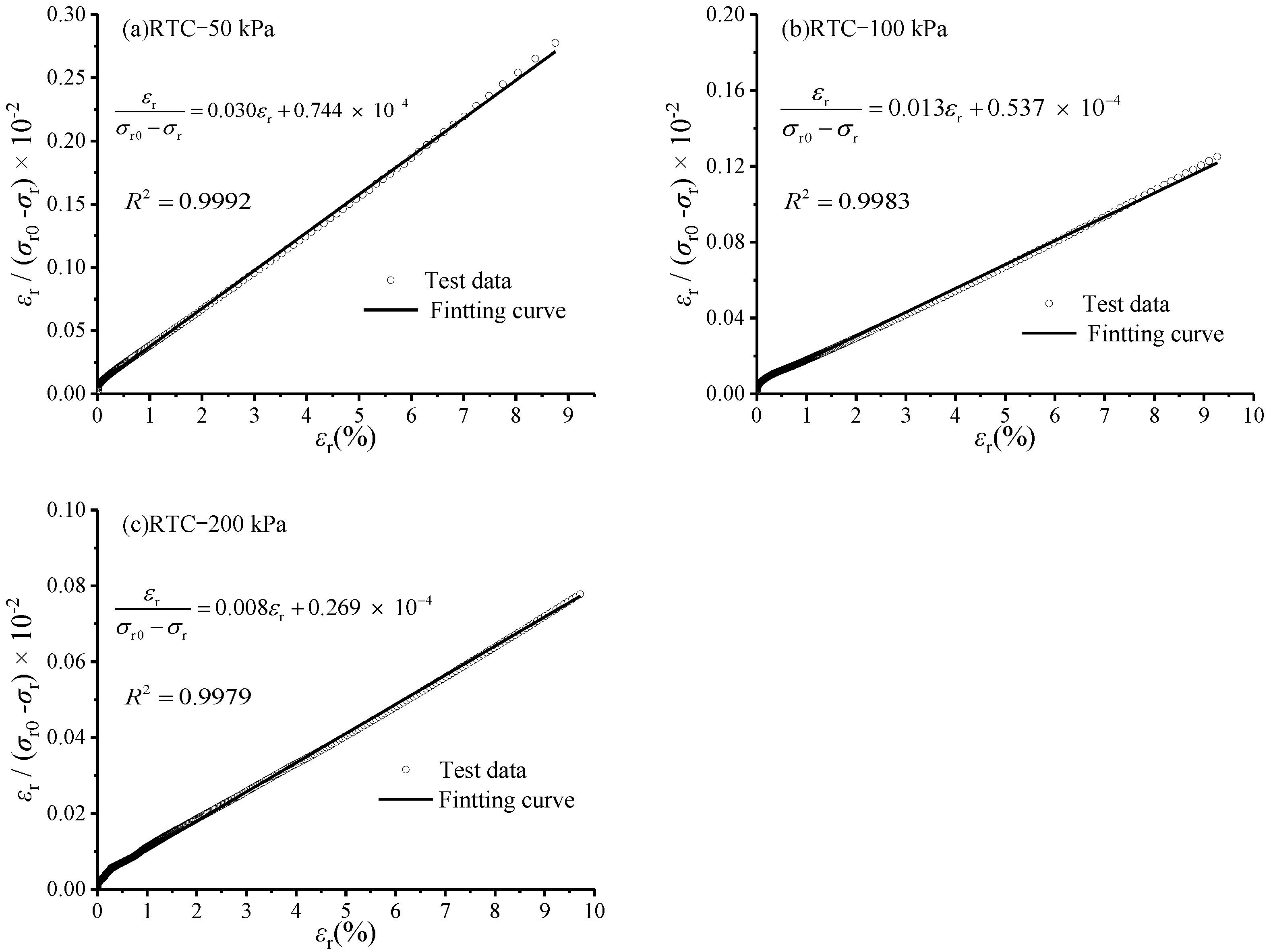
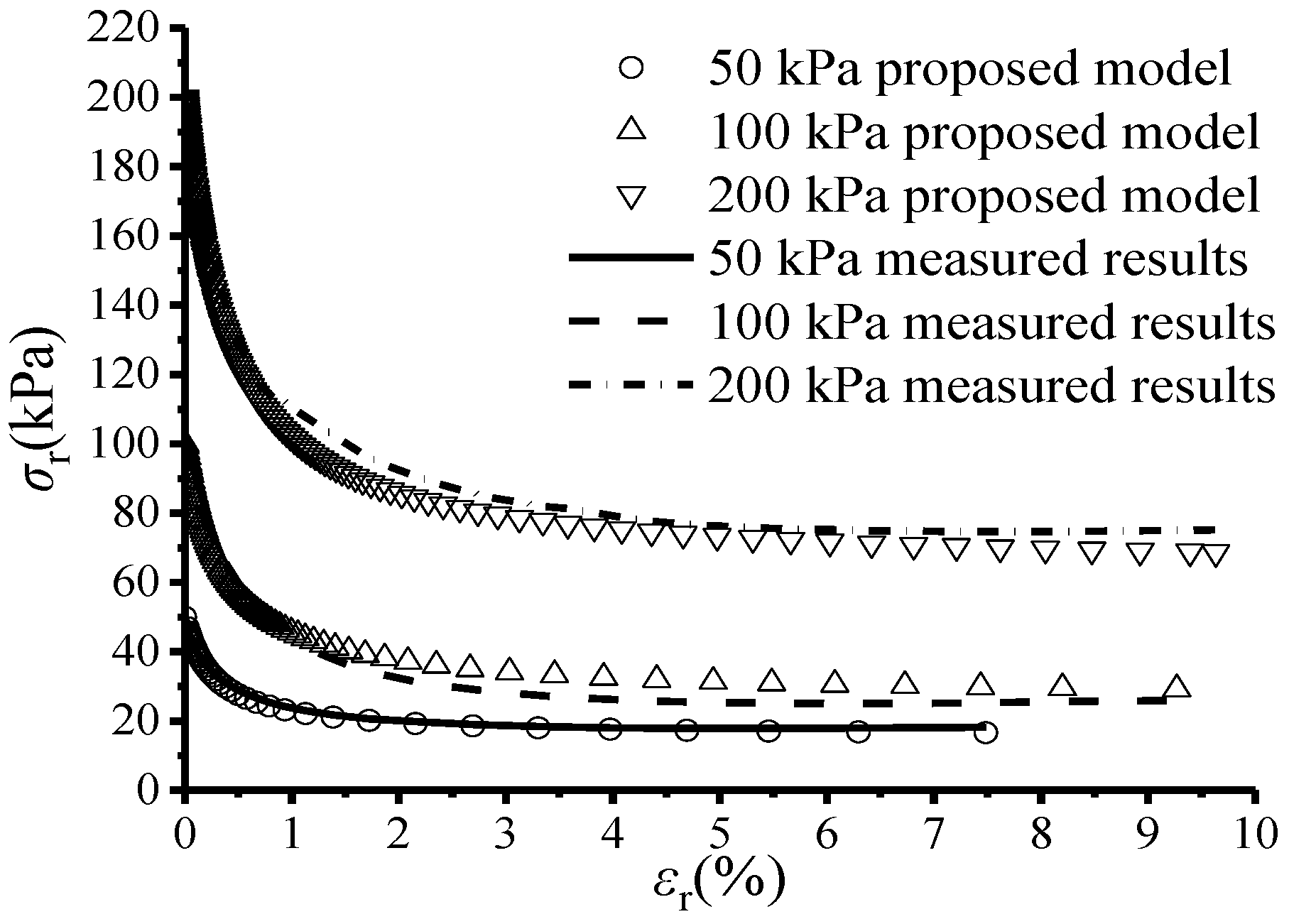


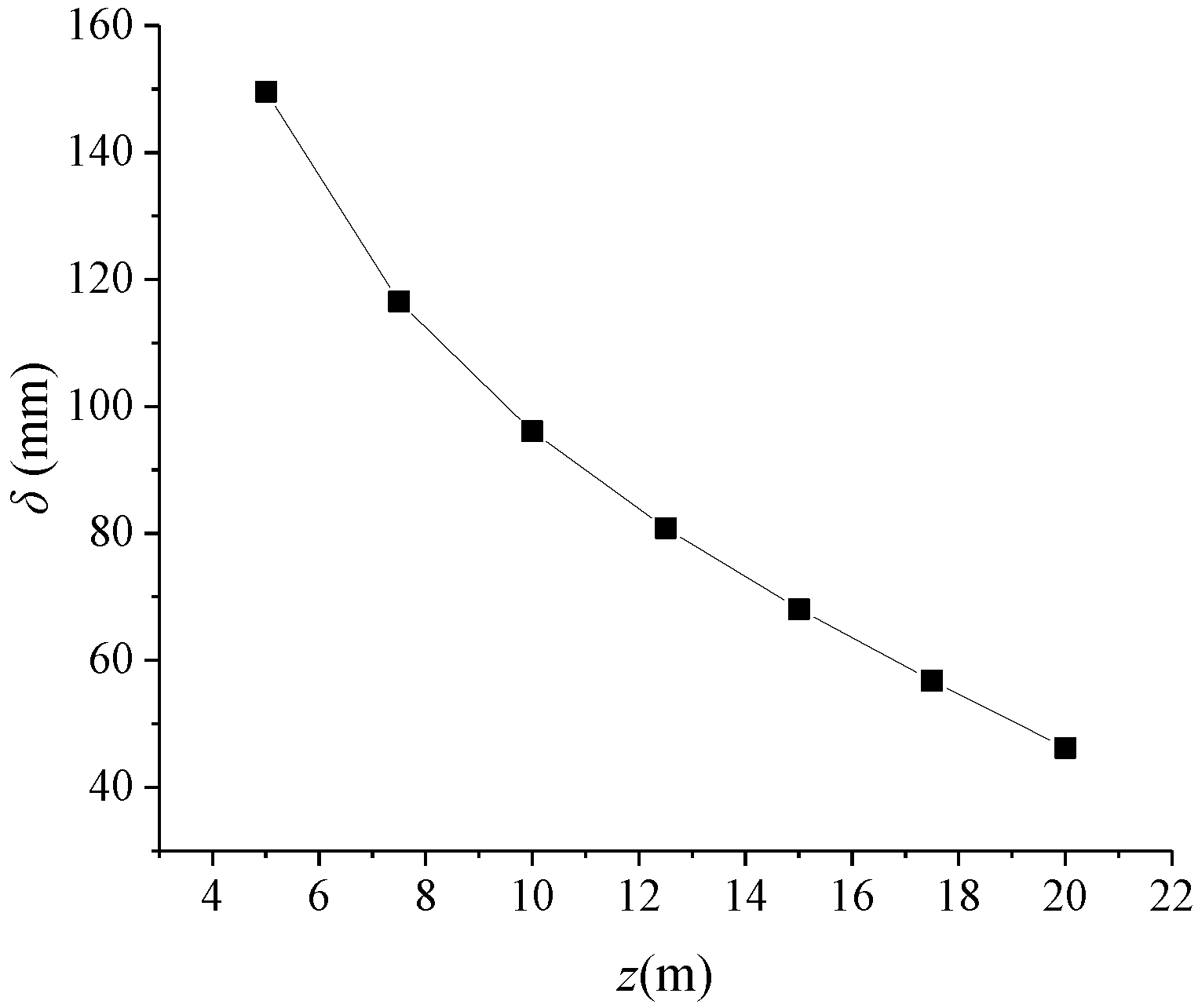

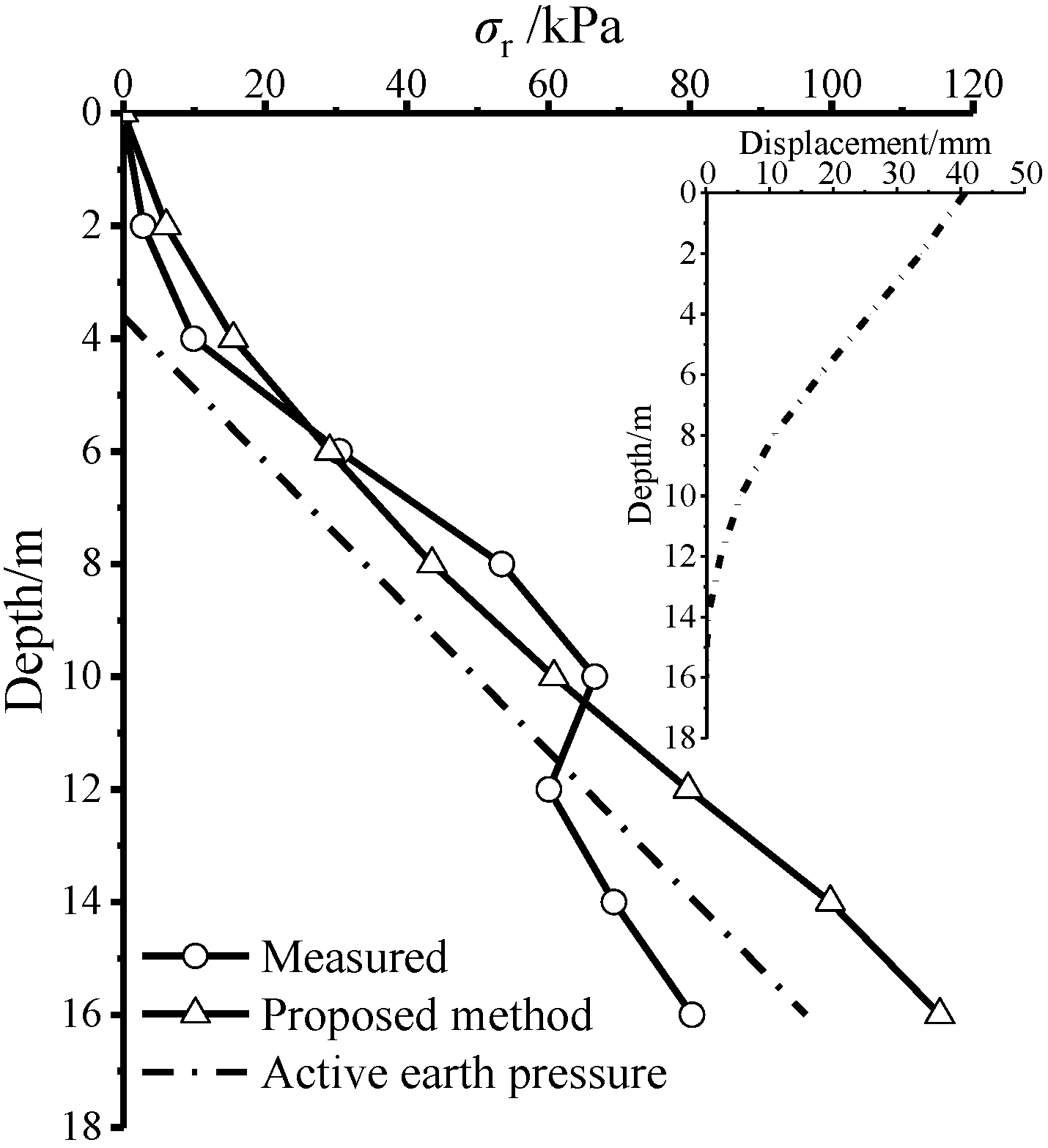

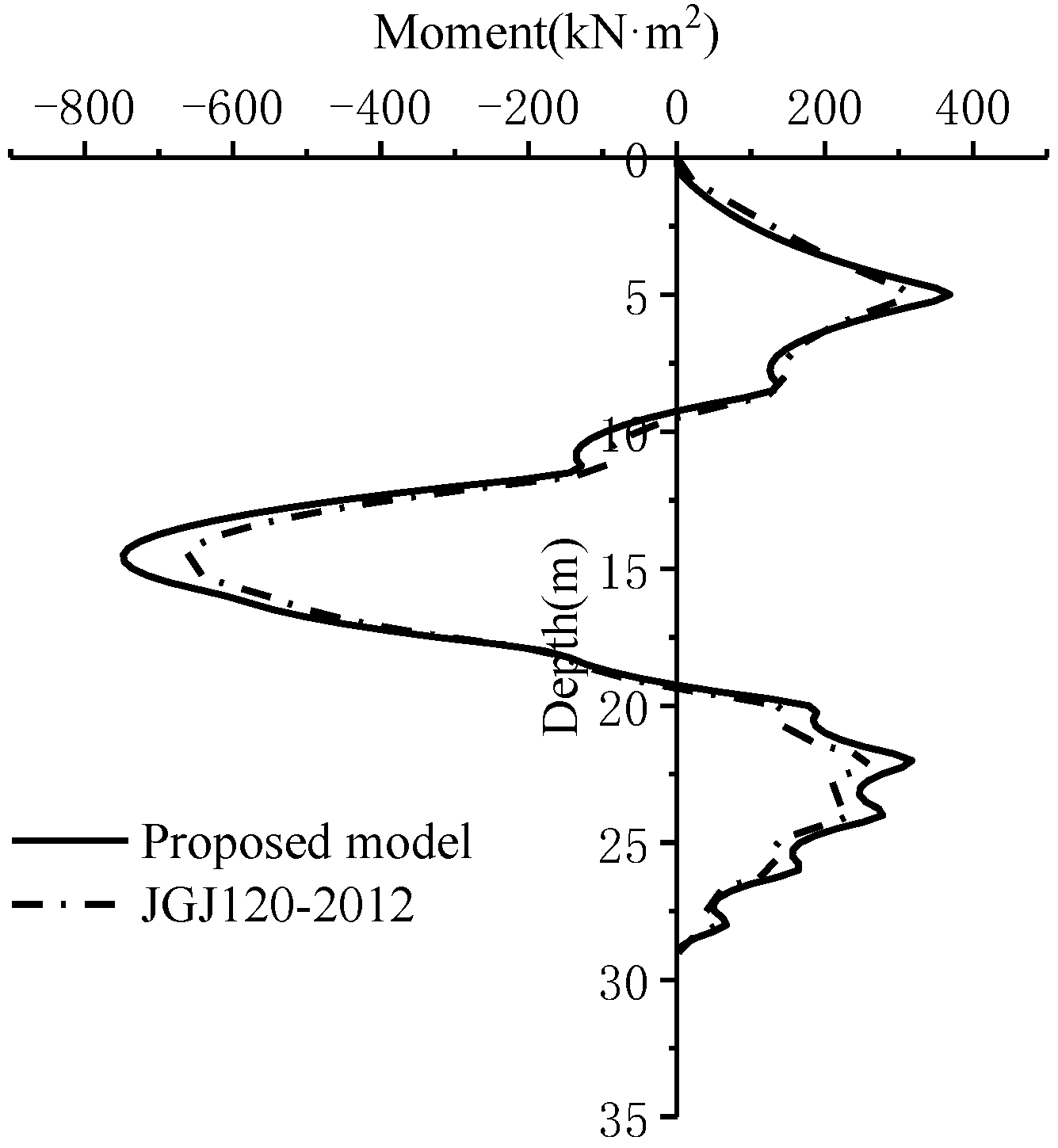
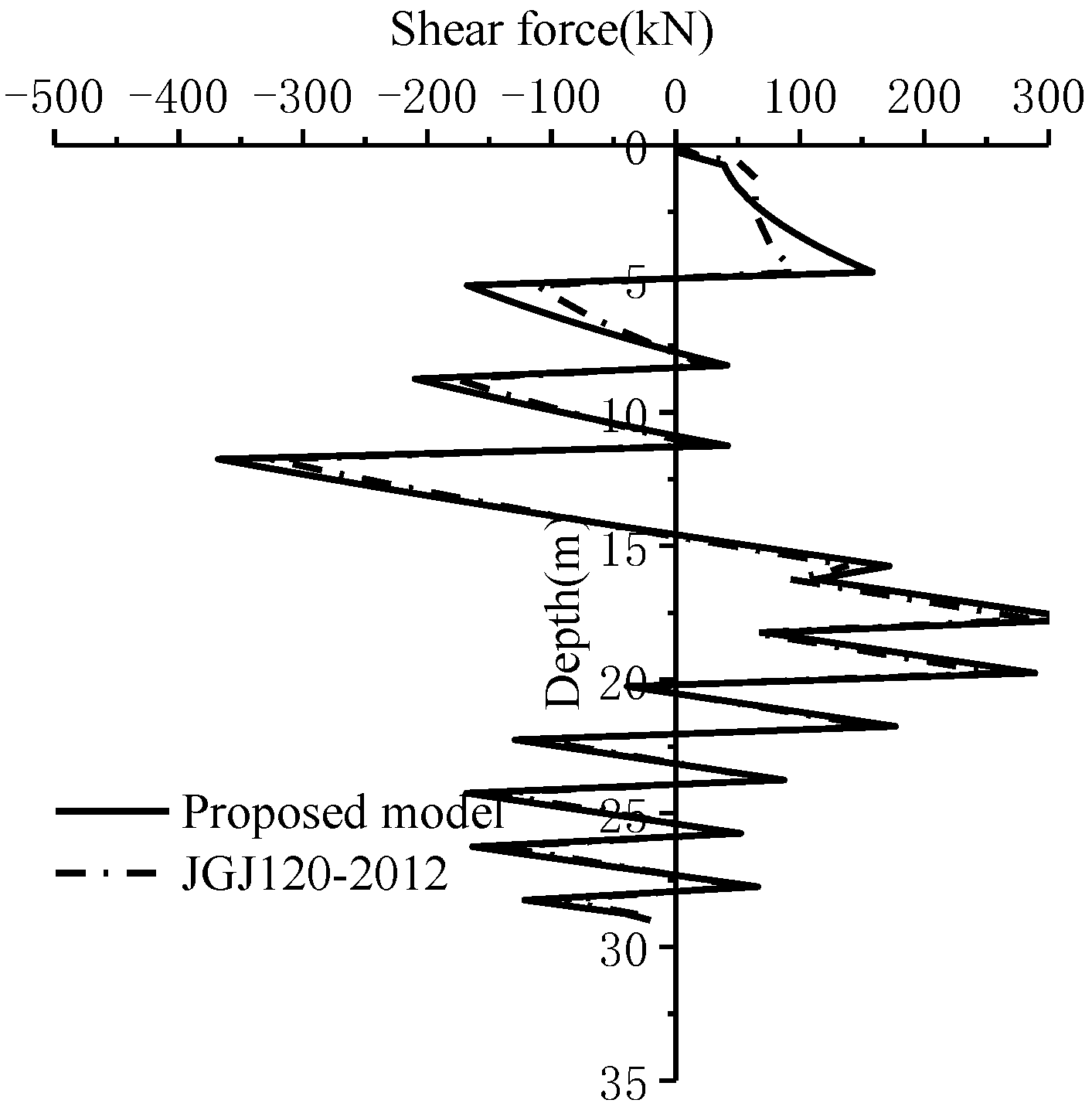
| Soil Strata | Layer Thickness (m) | Specific Gravity Gs | Plasticity Index IP (%) | Liquidity Index IL (%) | Unit Weight γ (kN/m3) | Void Ratio e | Water Content Ω (%) | Cohesion c (kPa) | Friction Angle φ (°) |
|---|---|---|---|---|---|---|---|---|---|
| Fill | 2.61 | 2.72 | 13.4 | 0.64 | 19.12 | 0.78 | 28.4 | 20.1 | 17.4 |
| Silty Clay | 2.13 | 2.72 | 12.9 | 0.57 | 19.01 | 0.81 | 28.5 | 17.4 | 19.8 |
| Silty | 3.63 | 2.71 | 9.9 | 0.68 | 19.33 | 0.72 | 26.5 | 14.8 | 29.9 |
| Muddy Clay | 10.52 | 2.74 | 14.7 | 1.14 | 18.42 | 1.07 | 39.02 | 10.9 | 11.9 |
| Silty Clay | 9.69 | 2.74 | 14.9 | 0.43 | 19.59 | 0.74 | 25.3 | 49.3 | 18.3 |
| Number | Cell Pressure (kPa) | Axial Pressrue (kPa) | K0 |
|---|---|---|---|
| 1 | 50 | 63 | 0.79 |
| 2 | 100 | 131 | 0.76 |
| 3 | 200 | 261 | 0.77 |
| Stiffness (MN·m2/m) | m (MN·m4/m) | ||
|---|---|---|---|
| Support | Concrete Strut | Steel Strut | |
| 1189.43 | 142.63 | 36.40 | 5.68 |
Publisher’s Note: MDPI stays neutral with regard to jurisdictional claims in published maps and institutional affiliations. |
© 2022 by the authors. Licensee MDPI, Basel, Switzerland. This article is an open access article distributed under the terms and conditions of the Creative Commons Attribution (CC BY) license (https://creativecommons.org/licenses/by/4.0/).
Share and Cite
Lu, N.; Li, W.; Zhou, J.; Zhou, S. Calculation of Displacement-Dependent Active Earth Pressure for Deep Excavations in Soft Soil. Appl. Sci. 2022, 12, 7289. https://doi.org/10.3390/app12147289
Lu N, Li W, Zhou J, Zhou S. Calculation of Displacement-Dependent Active Earth Pressure for Deep Excavations in Soft Soil. Applied Sciences. 2022; 12(14):7289. https://doi.org/10.3390/app12147289
Chicago/Turabian StyleLu, Nan, Weibin Li, Jingfeng Zhou, and Sen Zhou. 2022. "Calculation of Displacement-Dependent Active Earth Pressure for Deep Excavations in Soft Soil" Applied Sciences 12, no. 14: 7289. https://doi.org/10.3390/app12147289






